Kia Sorento Vs Honda Pilot Comparison: Three-Row Throwdown

What size do you need: big, or really big?
That’s the question we’re posing here, bringing the Kia Sorento together with the venerable Honda Pilot. Both of these three-row crossovers offer more room for families and friends than the typical compact crossover, but stop short of the big-boned, body-on-frame SUVs out there.
Get a Quote on a New Kia Sorento or Honda PilotBut wait, you say, doesn’t Kia have the Telluride, a closer match, size-wise, to the Pilot? Yes it does. The Telluride is our favorite mid-size crossover (alongside its Hyundai Palisade sibling), and frankly, we know how that story ends. Instead, we want to know if the other three-row Kia, which first impressed us so much last winter, can run with the rest of the pack. Or does the Sorento’s tweener status find it in a crossover no man’s land? Let’s find out.
Interior and Cargo Space
Sorento: The Sorento’s interior picks up more than few styling cues from its big brother. The chunky center console, with seat temperature controls on either side of the wireless charger, is the most obvious cue. We like the trapezoidal air vents too, looking straight out of the original Death Star. Brushed metal highlights, including the textured panels on the doors, break up a lot of black. Kia has begun to adopt the conjoined infotainment/instrument panel approach, and the Sorento is no different. At least the screen in front of the driver is sunken in, so glare is practically non-existent. A big panoramic roof lets more light in.
The quilted leather front seats look great. They feel good too, with a wide range of adjustments making it easy to get comfortable. Headroom is 40.3 inches (1,024 mm), with legroom measuring 41.4 inches (1,052 mm). The second row perches are a little flatter, but there’s only an inch less headroom (39.1 inches / 994 mm), and actually more legroom (41.7 inches / 1,060 mm). This tester features captain’s chairs with a one-button solution to open up access to the way-back; a three-seat bench is standard on lower trims.
It’s the third row where the Sorento suffers most. Seating just two, it offers just 36.8 inches (935 mm) of headroom and 29.6 inches (752 mm) of legroom. The cargo hold is also on the small side, with 12.6 cubic-feet (357 liters) of space with all seats up. Drop the third row and that grows to 45.0 cubes (1,274 L); turn the Sorento into a two-seater and you’ve got 75.5 cubes (2,139 L) to work with.
Pilot: The Pilot’s pilot will find a traditional Honda dashboard in front of them. Everything is laid out clearly, though the amount of piano black in here means they’ll find fingerprints within about 0.02 seconds of getting inside. The climate control rocker switches are pleasantly tactile; the tacked-on look of the surrounding section, less so. We also aren’t fans of the cheap-feeling wheel-mounted controls. The Pilot does have an absolutely enormous center console though, one that can be used as a makeshift table without fear of things falling off. That means fold-down armrests for the driver and front passenger, too. A large second-row moonroof brightens up the back seats. We’d prefer a smaller gap between it and the front glass, but there needs to be a space to mount that in-flight entertainment screen.
The front seats are like lounge chairs, huge and soft. They lack the lateral support of the Sorento’s thrones, but you’re not going to be ripping around corners on the regular in either. Breaking out the tape measure, there’s 39.5 inches (1,004 mm) of front headroom, and 40.9 inches of legroom—less than the Sorento. More problematic for this author is the floor-mounted parking brake, which is positioned in just such a way to hit the shin when trying to stretch the left leg on longer drives.
We really enjoy the Pilot’s second row, which is more spacious and more comfortable than the middle pair of seats in the Sorento. There’s 39.9 inches (1,014 mm) of headroom, and while Honda says there’s just 38.4 inches (976 mm) of legroom, it doesn’t feel pinched. Adults won’t question your friendship if you stick them in the third row, either. Headroom is a perfectly reasonable 38.9 inches (989 mm) back there, and legroom stands at 31.9 inches (810 mm). Three abreast might be a squeeze, but at least it’s possible, unlike in the Kia.
The Pilot’s more generous proportions also allow it to haul more stuff. Standard trunk space is 18.5 cu-ft (524 L), expanding to 55.9 cu-ft (1,583 L) and an enormous 109.2 cu-ft (3,092 L) when dropping the third and second rows, respectively.
SEE ALSO: Kia Carnival vs Chrysler Pacifica vs Toyota Sienna ComparisonBottom Line: The Pilot is simply enormous inside. Front-row passengers won’t notice the difference, but those behind will, especially in the third row. That it fits an extra person is important, too: it can be the difference between having to take an extra car or not.
It can’t win the space race, but the Sorento isn’t without its charms. The interior is more visually interesting, and there’s little between these two in terms of material quality.
If you’re buying a three-row crossover, you likely value space. The Honda has more of it, and it takes the lead in the first category.
Tech and Features
Sorento: The Sorento comes as standard with an 8.0-inch touchscreen, including wireless Apple CarPlay and Android Auto functionality. Higher-spec testers like this one bump the screen up to 10.25 inches, though lose the wireless ability. Kia’s latest infotainment system is slick, though we would have preferred physical buttons framing the screen. It’s a snappier user interface than the one in the Pilot, too.
Technophiles will appreciate the Sorento’s crisp, 12.3-inch digital instrument panel. It includes multiple themes, and scrolling through the various bits of info is easy-peasy. There’s also a head-up display, exclusive to this top trim. The AutoGuide team never says no to a HUD. There are enough USB ports in here for every seat to charge at least one piece of tech, too.
Seat heating is included on the front four seats, and ventilation on the front row. The Sorento only includes dual-zone climate control, however. A heated steering wheel is also included.
Pilot: Every Pilot sticks to the same 8.0-inch screen as this Black Edition tester. It’s fine. The tile-like user interface is easier to use at a quick glance, but the screen is laggier than the larger unit in the Sorento. You’ll need a leash for either Apple CarPlay or Android Auto, too. The Pilot offers a WiFi hotspot, as well.
The digital portion of the instrument cluster relays all the important info seamlessly. It does feel a little old-school with the partitions, though. Honda doesn’t offer a head-up display on the Pilot, regardless of trim. Even on the Black Edition, you’ll only find four USB ports, as well. This can result in some device charging juggling—a minor annoyance, admittedly—but be warned.
Like the Sorento, the Pilot comes with heated and ventilated front seats, plus a heated second row. The steering wheel is heated, too. Despite it being a sweltering week in August, we tested both, because that’s what we do. The Pilot’s wheel gets warmer, quicker. The larger Honda also benefits from tri-zone climate control.
The Honda’s advantages are family-focused. CabinTalk allows the driver to easily converse with the way-back, and the second-row entertainment screen can be a lifesaver on longer road trips. Multi-zone audio means you won’t have to listen to that 300th rewatch of Paw Patrol, either.
Bottom Line: Don’t let its lower sticker fool you: the Sorento gives up little to the pricier Pilot. If you crave the latest driver-focused tech, like a head-up display, 360-degree camera, and a better stereo, the Kia has the edge. If you’re regularly shuttling around young ones, the in-cabin PA system and second-row entertainment makes the Honda mighty appealing.
Powertrain, Driving Feel, and Fuel Economy
Sorento: This Sorento tester comes equipped with the optional 2.5-liter turbocharged engine. The four-cylinder has quickly spread across the Hyundai group, and with good reason; it’s a torquey, responsive unit. Horsepower sits at 281, with a stout 311 pound-feet of torque arriving at just 1,700 rpm, and lasting until 4,000 rpm. An eight-speed dual-clutch transmission handles shifting duties.
The result is a surprisingly spritely mid-sized crossover. The DCT avoids much of the jerkiness found in other applications, allowing the Sorento to surf along on its ample torque. When the throttle dips deeper for passing duties, the Sorento responds quickly—and there’s wheel-mounted paddles if you’d rather tell it what to do.
Being lighter and smaller, the Sorento is easier to place on the road. Its steering has more weight, building driver confidence and even sparking a bit of fun. There are numerous driving modes, though we never took the Sorento far off-road to test some of them. The most it had to tackle were some cottage roads, which it handled with aplomb thanks to 8.2 inches (208 mm) of ground clearance.
The EPA rates the 2021 Kia Sorento at 21 mpg city, 28 mpg highway, and 24 mpg combined. That’s with the turbo engine; despite being down 90 horsepower, the base engine posts broadly similar numbers. Canadian figures are 11.1, 8.4, and 9.9 L/100 km, respectively.
Pilot: No matter which Pilot you buy, it comes equipped with Honda’s tried-and-true 3.5-liter V6. It gives up just a single horsepower to the Sorento, with 280 hp at a VTEC-happy 6,000 rpm. Torque is a very different story, with 262 lb-ft coming on at a relatively high 4,700 rpm. A nine-speed automatic is the only transmission choice.
Around town, the V6 is solid. The transmission will occasionally hunt for the right ratio, but largely, the Pilot is a quiet, smooth mode of progress. Ask more of it on the highway, and it’ll provide the iconic VTEC yell, but can’t match the surge from the Sorento. It’s not slow, but the Pilot is packing a few extra hundred pounds, after all.
The steering is light and pretty feel-free, too. If you find yourself on a backroad with nobody else in the car, the Pilot is not going to goad you into having a bit of fun. It’s just not that type of vehicle.
According to the EPA, the AWD Pilot will return 19 mpg city, and 26 mpg highway, for a combined rating of 22 mpg. Canadian figures are 12.4, 9.3, and 11.0 L/100 km, respectively.
Bottom Line: The Honda simply does what is asked of it, nothing more. The Kia packs the more rewarding powertrain, and its steering is sweeter. That it also wins at the pumps, without needing premium fuel like most turbo engines, makes it the easy pick for this category.
Of note: we beat the quoted highway figures in both vehicles by a few mpg.
Safety
Sorento: Every Sorento includes automated emergency braking, lane-keep assist, lane following, and auto high-beams. Cyclist detection for the automated braking, plus blind-spot monitoring and rear cross-traffic alert, show up one trim up. You’ll need to cough up for this top trim to gain access to Highway Drive Assist, adaptive cruise control, a 360-degree camera, and Blind View Monitor.
According to the National Highway Traffic Safety Administration (NHTSA), the 2021 Sorento scores four out of a possible five stars for crash safety. The Kia aced the side crash tests, while its frontal crash and rollover risk ratings were all four stars. Meanwhile, the Insurance Institute for Highway Safety (IIHS) rates the Sorento a Top Safety Pick. The IIHS dinged the three-row for poor headlight performance, except on this SX trim, which scores a top Good rating. The Sorento earned an Acceptable for its LATCH child seat ease-of-use, too.
Pilot: Like the Kia, the Honda scores an Acceptable rating for its child seat setup from the IIHS. Everything else is subtly different, though: the Pilot misses out on a Top Safety Pick rating, with an Acceptable (as opposed to Good) passenger-side small overlap front crash rating. Over at the NHTSA, the Pilot does see an overall five-star rating.
As part of its last round of updates, the Pilot now includes automated emergency braking, road departure mitigation, lane departure warning, lane-keep assist, auto high-beams, adaptive cruise control, and blind-spot information with cross-traffic alert. On every trim (in America; Canada locks the latter two features to the Touring and Black Editions). You’ll need to graduate to mid-tier trims and above for parking sensors. The Pilot’s backup camera is grainy, but it at least offers multiple angles and dynamic guidelines.
Bottom Line: Both the Sorento and Pilot offer a lot of active and passive safety equipment in their as-tested forms. The Pilot offers more standard kit across its trim walk, however. To counter that, the Sorento includes a 360-degree camera as well as Kia’s clever Blind View Monitor. The crash test ratings are essentially a wash. Call this one a tie.
Styling
Sorento: We’re big fans of the Sorento’s styling. The old one looked like a fun-house-mirror minivan—and not a cool minivan, like the new Carnival. This latest Sorento has a sharper edge to it, all squinty headlights merged with a widescreen rendition of the Tiger Nose grille. Those simple two-line LED daytime running lights (DRLs) make it easy to identify at night, too—we just wish they were yellow, like the very cool items on the K5 sedan.
SEE ALSO: 2022 Kia Carnival Review: Minivan MakeoverWhere the Pilot goes for softer curves, the Sorento has more angles than a Myspace page from 2005. The rear window line is mirrored in the side of the taillights, which are split down the middle by a thin sliver of bodywork. The reverse-rake shark fin aft of the rear doors is a design detail that looks to be spreading, in different forms, across the Kia range.
The gloss black lower body trim helps the Sorento feel a little more premium than the Pilot’s plain plastic. Will a trip off-road show scratches more easily? Sure, but we don’t expect many owners of either of these two to be tackling the brush often.
Pilot: Honda’s design team has grafted the brand’s corporate schnoz onto an enormous two-box shape. That’s really all there is to the Pilot. Park it up next to anything else in the class, and Honda’s three-row crossover looks like it’ll swallow up more people and their stuff than anything else. That’s not an empty promise, either.
The wrapper may lack the stand-out features present on the Sorento, but there’s a quiet attractiveness to the Pilot’s minimal detailing. An upswept character line breaks up the flanks nicely, and we appreciate how the head- and taillights mirror one another. Speccing the Black Edition in Platinum White Pearl shows someone at Honda has a sense of humor, too. With the added contrast the bright paint provides, the Pilot looks pretty good this way, though we’d prefer the regular two-tone Touring/Elite wheels.
Bottom Line: There’s only so many ways to say “looks are subjective.” For what it’s worth, this author finds the Sorento more visually interesting, and not just because it’s a design half a decade younger than the Pilot’s.
Pricing and Value
Sorento: To get in at the ground floor of Sorento ownership requires $30,565 ($35,845 CAD). For that tidy sum, you’ll net a front-drive LX model in the US; all-wheel drive is another $1,800 surcharge, on every trim. In Canada, AWD is standard across the board, hence the comparatively higher asking prices.
This tester is a Canadian-spec SX ($49,345 CAD), known as the SX Prestige ($41,765) in the US. It’s easily identifiable thanks to those big 20-inch alloys, gloss black trim, and power-folding mirrors. Kia throws everything it has at the top-level Sorento, including the 10.25-inch touchscreen, a 12.3-inch, customizable digital instrument panel, heated and ventilated front seats, navigation, voice recognition, a 12-speaker Bose sound system, and more. A heated steering wheel is also included, though that shows up elsewhere in the lineup in chilly Canada.
A note about market differences: in Canada, the X-Line is a mid-level trim on its own, and one of the cheapest ways to nab the turbocharged engine. In America, the X-Line is an option pack only on the SX Prestige, coming bundled with AWD for an even $2,000 instead of the $1,800 up-charge on the rest of the trims. That means our $49,595 CAD tester doesn’t have an exact US-market equivalent, but the closest would ring in at $43,765.
Pilot: The Pilot is larger, and has just the one engine in its lineup. It should come as no surprise, then, that it’s the pricier option. We’re talking nearly 10 grand more, on either side of the border. A front-drive, base-model Pilot goes for $40,285 in the US, with AWD a $2,000 option. The latter is standard in Canada, where the starting price is $44,475 CAD.
The Black Edition is essentially an Elite (Touring seven-passenger in Canada) with the de rigueur black exterior trim bits. A panoramic roof lets more light into the spacious interior, and it’s quieter than base Pilots thanks to laminated front windows. Like the Sorento, the Pilot includes heated and ventilated front seats, plus heated second-row captain’s chairs. An 8.0-inch touchscreen handles infotainment duty, with a hybrid analog/digital instrument panel. Wireless charging and native navigation are both included, too.
As equipped, our 2021 Honda Pilot tester rang up at $52,240 ($58,375 CAD).
Bottom Line: You’re certainly getting more crossover with the Pilot. But is it worth the roughly 20-percent higher as-tested price? That’s a tougher question. The Pilot’s major advantages are more space and its in-car entertainment features.
Kia hasn’t given up that strong value angle. Its top-end pricing is barely higher than the entry point for the Pilot, yet the Sorento gives up precious few features when comparing like for like. Another category win for the Kia, then.
Verdict: Kia Sorento vs Honda Pilot Comparison
Let’s get back to that original question: do you want big, or bigger?
If space is your primary concern, then the Honda Pilot is the only answer. Whoever spends time in the back two rows will thank you, especially if they’re movie fans. It’s the more family-focused offering; though both the Odyssey and Carnival are better still when the whole brood is in tow.
For us, the 2021 Kia Sorento’s price point and driving experience more than make up for its slightly tighter accommodations. It includes nearly all the creature comforts of the Honda, and you can always use the savings to buy a small fleet of tablets and headphones. Or a family vacation.
Become an AutoGuide insider. Get the latest from the automotive world first by subscribing to our newsletter here.

Kyle began his automotive obsession before he even started school, courtesy of a remote control Porsche and various LEGO sets. He later studied advertising and graphic design at Humber College, which led him to writing about cars (both real and digital). He is now a proud member of the Automobile Journalists Association of Canada (AJAC), where he was the Journalist of the Year runner-up for 2021.
More by Kyle Patrick



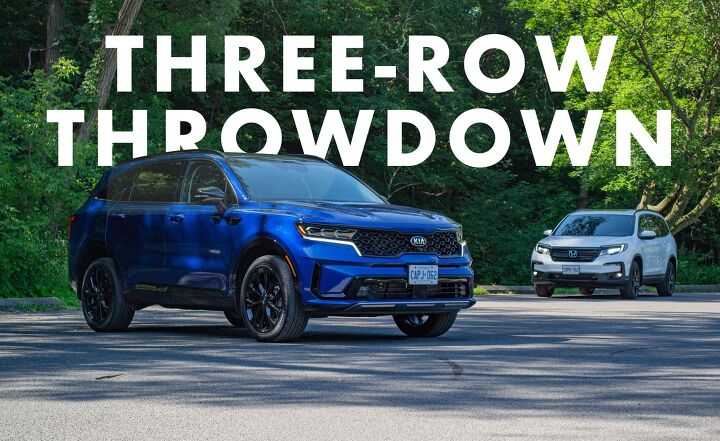
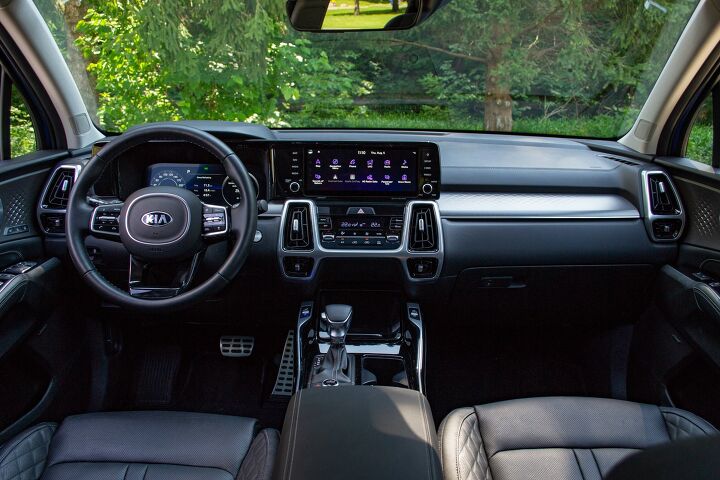

































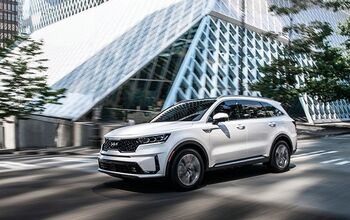
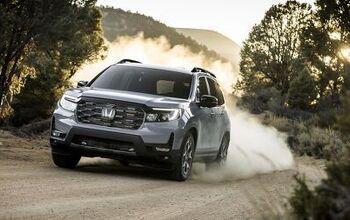
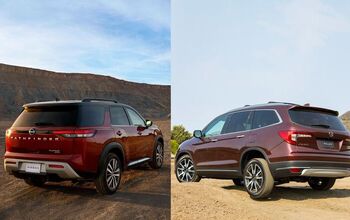
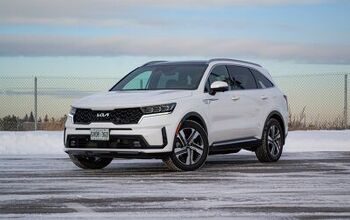











Comments
Join the conversation